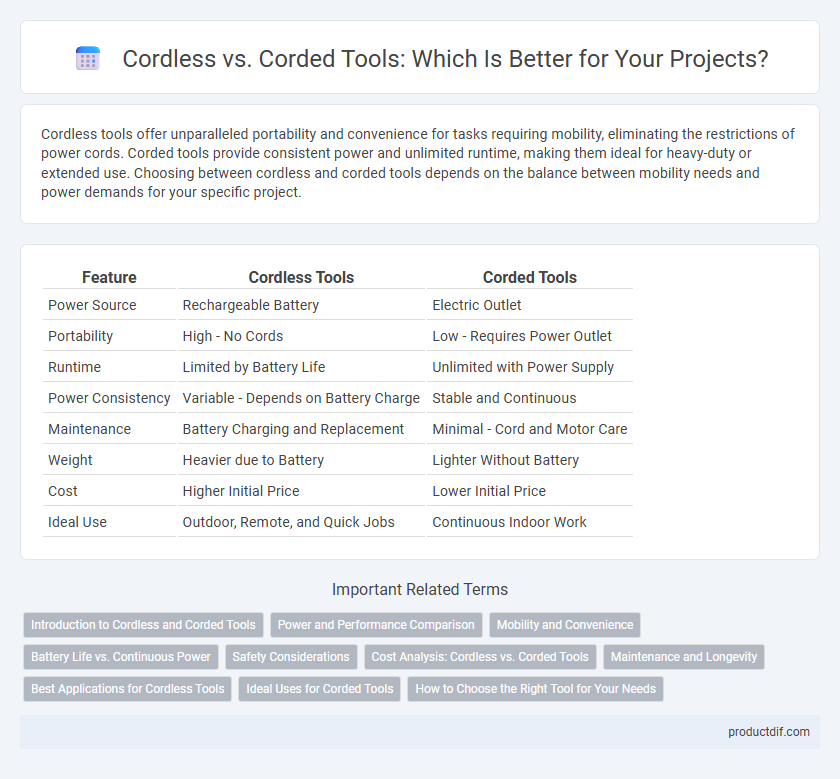Cordless tools offer unparalleled portability and convenience for tasks requiring mobility, eliminating the restrictions of power cords. Corded tools provide consistent power and unlimited runtime, making them ideal for heavy-duty or extended use. Choosing between cordless and corded tools depends on the balance between mobility needs and power demands for your specific project.
Table of Comparison
| Feature | Cordless Tools | Corded Tools |
|---|---|---|
| Power Source | Rechargeable Battery | Electric Outlet |
| Portability | High - No Cords | Low - Requires Power Outlet |
| Runtime | Limited by Battery Life | Unlimited with Power Supply |
| Power Consistency | Variable - Depends on Battery Charge | Stable and Continuous |
| Maintenance | Battery Charging and Replacement | Minimal - Cord and Motor Care |
| Weight | Heavier due to Battery | Lighter Without Battery |
| Cost | Higher Initial Price | Lower Initial Price |
| Ideal Use | Outdoor, Remote, and Quick Jobs | Continuous Indoor Work |
Introduction to Cordless and Corded Tools
Cordless tools offer enhanced portability and convenience by operating on rechargeable batteries, ideal for jobs without easy access to power outlets. Corded tools provide consistent power supply and typically deliver higher performance for heavy-duty tasks due to direct connection to electrical sockets. Understanding the differences in power sources helps professionals and DIY enthusiasts select the right tool for efficiency and reliability in various applications.
Power and Performance Comparison
Corded tools typically offer consistent power output and higher performance due to direct connection to an electrical source, enabling continuous operation without battery limitations. Cordless tools provide greater portability and flexibility but often have reduced power and runtime constrained by battery capacity and charge cycles. Advances in lithium-ion battery technology have improved cordless tool performance, yet corded variants remain superior for heavy-duty, prolonged tasks requiring maximum power.
Mobility and Convenience
Cordless tools offer superior mobility by eliminating the need for power outlets, allowing users to work freely in remote or tight spaces. They provide convenience through lightweight designs and quick battery replacement or charging, enhancing productivity on the go. Corded tools, while powerful and consistent in performance, limit movement due to cord length and dependency on electrical sources, making them less flexible for mobile tasks.
Battery Life vs. Continuous Power
Cordless tools offer the advantage of portability but rely heavily on battery life, which can limit usage time and require recharging after extended tasks. Corded tools provide continuous power without interruptions, making them ideal for long-duration work where consistent performance is critical. Choosing between cordless and corded depends on balancing the need for mobility against uninterrupted power supply for specific job requirements.
Safety Considerations
Cordless tools reduce the risk of trip hazards and electrical shocks since they operate without power cords, enhancing user safety in various work environments. Corded tools, while providing consistent power, require careful handling to avoid cable damage and potential electrical hazards. Proper maintenance and inspection of both tool types are essential to ensure operational safety and prevent accidents.
Cost Analysis: Cordless vs. Corded Tools
Corded tools typically offer a lower upfront cost compared to cordless models due to simpler design and lack of batteries. However, cordless tools incur higher long-term expenses from battery replacements and chargers, which can increase total ownership costs. Evaluating usage frequency and mobility needs is crucial in determining whether the initial savings of corded tools outweigh the convenience and flexibility provided by cordless options.
Maintenance and Longevity
Corded tools generally require less maintenance due to their simpler internal components and consistent power supply, reducing wear on motors and batteries. Cordless tools demand regular battery care, including proper charging cycles and storage to prevent capacity loss and extend lifespan. Investing in higher-quality batteries and following manufacturer maintenance guidelines can significantly improve the longevity of cordless tools.
Best Applications for Cordless Tools
Cordless tools excel in applications requiring portability and flexibility, such as landscaping, home repairs, and overhead tasks where power outlets are inaccessible. Their battery-powered design enables users to work in remote or confined spaces without the limitation of cords, making them ideal for outdoor construction and maintenance. High-capacity lithium-ion batteries further enhance cordless tools by delivering longer run times and consistent power for professional-grade performance.
Ideal Uses for Corded Tools
Corded tools deliver continuous power, making them ideal for heavy-duty tasks requiring sustained operation, such as large-scale construction projects or extensive woodworking. They are preferred in workshops and job sites where mobility is less critical but consistent performance is essential. Their reliance on an electrical outlet ensures no downtime due to battery depletion, enhancing productivity for long-duration applications.
How to Choose the Right Tool for Your Needs
Choosing between cordless and corded tools depends on mobility requirements and power needs; cordless tools offer portability and convenience for outdoor or remote use, while corded tools provide consistent, uninterrupted power ideal for heavy-duty tasks. Battery life and voltage are critical factors for cordless tools, determining operational time and strength, whereas corded tools rely on outlet accessibility and voltage compatibility for optimal performance. Assessing job duration, task intensity, and work environment ensures selection of a tool that balances efficiency, power, and convenience.
Cordless vs Corded Infographic

 productdif.com
productdif.com